2.2 Magnetism caused by moving charged particles
2.2.1 The magnetic effect among moving charged particles
An individual moving article has a localized magnetic field that moves
with the particle. Traditional static magnetic field (H) is defined by the closed current (i). The shape of static magnetic field is formed by accumulation of moving
local magnetic effects. Individually moving charged particles have a localzed
magnetic effect that moves to the vicinity of the particle. In case where
charged particles move uniformly, (H) is linearly related to (i). However, the isolated charged particles that fly are not uniform.
The magnetic reaction by moving isolated charged particle is differed from the static magnetic field. Magnetic field lines are imagined lines that
indicate the direction in which the magnetic action works, and does not react. The explanation that the Earth has a geomagnetic field and that
its magnetic field lines surround the Earth is protected from charged particles lying from the Sun is incorrect. The reason why H+does not reach to the ground is not geomagnetis but collision with molecules
in the atmosphere on the Earth. Tthe mean free path of atmospheric molecules is about 1 μm..
In quantum mechanics, the behavior of charged particle is calculated in terms of energy Electrostatic energy is given by electrostatic potential
(φ), The electrostatic force is given the electric field (E=gradφ) multiplied by the charge.. On the other hand, according to Biot-Savard's law, the tangential torque (FL) perpendicular to the direction of the magnetic field is a variation of
the angle of rotation of the rotational energy.
FL = - (qv)xB (1)
Torque is given by manipulating rot of the energy (Um) of rotational motion.
rot (Um) =FL = - (qv) xB (2)
Therefore, we define vector potential A as Eq.(3)
B = rot A. (3)
The formula (1) is in differential form, and we think of it in integral form according to Stokes’ theorem.
A line integral of tangential component of boundary corespnd to the area integral of vertical comonent.
The line integral on tangential componentn of rotA in the surrounding area corresponds surrounded area integral of Bi.e.the magnetic flux (Φ).
The energy of the rotational motion of charged particles (Um) (Um) is given by equation (4).
Um= - (qv)・A (4)
The negative sign of equation is set to be low energy when v and A are parallel. This is indicated by a magnetic phenomenon, ex two conductors
attract each other when an electric current is passed through them in the same direction. Pinch effect, in which charged particles running flat shrink
into thin lines, is used in nuclear fusion experiments. These are phenomena in which charged particles running in parallel are magnetically coupled.
There is a magnetic effect of attraction between charged particles of the same type traveling in the same direction, and a magnetic action that repels
charged particles traveling in the opposite direction.
2.2.1 a) Relationship between current i and vector potential B
As shown in Fig. 2.2.1, the magnetic field B surrounds the current i and A surrouds B. The rotion of rotational energy yields rotational torque. The rotaton of A has an effect of current i. It provides magnrtic force of torque. The magnetic effect of a moving charged particle is a short-range force. The force decreases as it moves away from the charged particle.
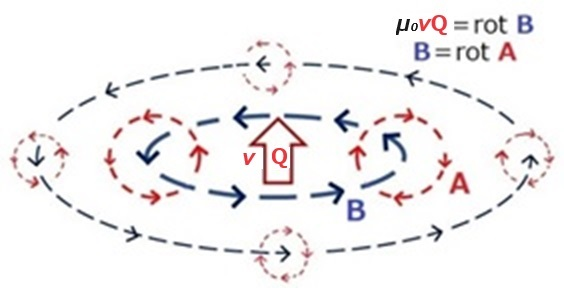
Fig.2.2.1 Vector potential A and magnetic field B those are generated by motion of charged particles
2.2.1.b) Understanding of magnetic coupling by the motion of charged particles
As shown in Fig. 2.2.2, if two magnets are placed vertically with the
N-S direction up and down, full force will act on the gap between the two
magnets, i.e. the charged particles that move the same direction produce
this magnetic coupling.
On the other hand, if the N-S direction of the two magnets is the same
and they are placed in parallel, a repulsive force will act in the gap
between the two magnets i.e., the left and right charged particlesre those
move in opposite directions by magnetic repulsive forces.. Pull force works
between charged particles moving in the same direction, however repulsive
forces works between charged particles moving in opposite directions.
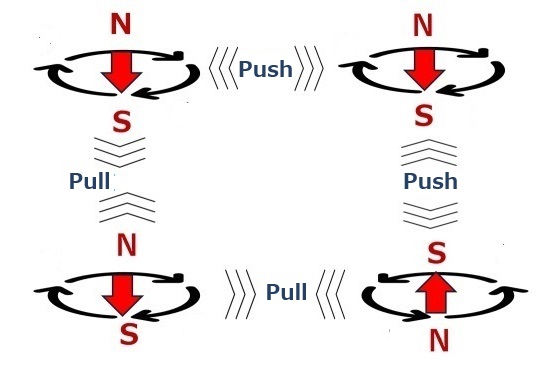
Fig.2.2.2 Maagnetic interaction expressed by moving charged particles in motion
2.2.1 c) Aharanov-Bohm effec: magnetic interaction among moving charged particles
The phase of electrons passing up and down at outside a solenoid are different, resulting in the appearance of interference fringes as shown in Fig. 2.2.3, The direction of the current flows in the solenoid is opposite between up and down. The vector potential A on the current is up and down in opposite directions. Therefore, the effect that the parallel current has a low energy and anti-parallel current has a high energy.There is a difference in the phase of the electrons passing above and below the outside of the solenoid. In 1986, Akira Tonomura succeeded in demonstrating this effect with a sample covered with a superconductor solenoid.
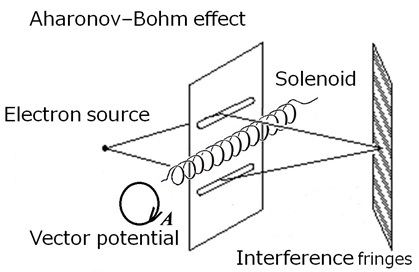
Fig.2.2.3 A-B effect shows the iInteraction of electron beem outside tand inside of solenoid
2.2.2 Magnetic effects in the Sun and solar wind
2.2.2.a) Behavior of charged particles in the surface of the Sun.
In the photosphere of the Sun, the density of charged particles is high and the temperature is 104 K, but in the Coronal region, the density of electrons decreases and temperature rises to 106 K. Between 3,000~10,000km from the photosphere An elongated protrusion
structure called "Spicule" has been observed. Since there is a magnetic coupling between charged particles moving at high speed, a bundle of the same charged particles running in parallel is formed. There, bundled protons (H+) are pulled back to the Sun by gravity to create a protrusion structure.
The spicule rises and descends by gravity, but there are charged particles that rise and forms the corona.
The velocity of the solar wind reacheg to the Earth is estimated from the escape velocity (vescape) on the solar surface.
If the mass of the Sun is Ms and R is the radius of the Sun, vescape=(2GMs/R)1/2=617.5(km/sec). Therefore, when the H+ released in bundles self-replication by magnetic coupling and becomes
a huge population, the flare occurs. Flares reach planets far from the
Sun without spreading due to the magnetic coupling. It isso called Magnetic-storm.
2.2.2.b) Interaction between charged particles in the Earth's interior
and the solar wind
Fig.2.2.3 shows the average intensity of the Earth's geomagnetic field according to the InternationalStandard Earth's magnetic field (IGRF). The intensity distribution of the Earth's geomagnetic field is due to the movement of the Earth's charged particles by the rotation of the Earth. The velocity of the Earth's charged particles is highest near the equator. The rotation speed disappears in the arctic and south poles. However, there is a large area near the equator where the geomagnetic field has weakened. From mid-latitudes to high latitudes, there is a region with a strong geomagnetic field. The region with the strongest geomagnetic field is near the boundary between the mid-latitudes and the high-latitudes. Why is the geomagnetic field near the equator weak? The magnetism that generates the motion of charged particles inside the Earth does not act far, but the solar wind is in motion in the sky with a group of charged particles (H+), and the charged particles moving in the movement are chained together and cause magnetism even if they leave the Earth. The geomagnetic field includes not only the motion of charged particles in the Earth's interior.

Fig.2.2.4 Average distribution of the Earth's geomagnetic field and its locational variation
(Data;2005 International Standard Geomagnetic Field(IGRF))
2.2.2.c) Interaction between the solar wind and the Earth's atmosphere
The Sun provides the Earth large thermal energy by iradduation of electro-magnetic wave. But it sends solar wind consists of H+. Since the H+has a muss,
the colision with atmouspheric partcles causes the movement of atomospher. The H+ of the solar wind is accompanied by a rotational motion in the counterclockwise direction due to the rotation of the Sun.
The solar wind of H+ passing through the eastern side of the Earth magnetically couples with the Earth's charged particles rotating in the counterclockwise direction.
However, the solar wind H+ passing through the western side of the Earth is "opposite" to the movement of charged particles on the Earth that is magnetically repelled.
In this way, the counterclockwise rotational motion of the solar wind interacts with the rotation of charged particles in the Earth,
causing the upper atmosphere of the Earth, as a whole to move the weather from west to east faster than its rotation. So, in the middle latitudes of the Earth, westerly winds blow. The weather in the west is moved to the east.
On the other hand, the solar wind collides head-on with the atmosphere near the equator in daytime hemisphere, the atmosphere is driven clockwise by a mechanism in which the gears mechanism.
It moves the atmosphere in the opposite direction to the rotation of the Earth in the counterclockwise direction of rotation It drives the trade wind.
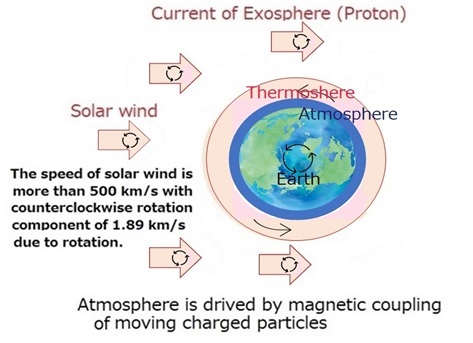
Fig.2.2.5 Interaction between the solar wind and the Earth's atomosphere
2.2.2.d) Diurnal changes in the geomagnetic field during the geomagnetic quiet day.
The geomagnetic field is affected by several factors, and these factors have various cycles of change from several hours to tens of thousands of years. There is a diurnal change in geomagnetism in which the Earth's magnetic field fluctuates regularly in a daily cycle. This phenomenon is clearly observed when the geomagnetic disturbance is small.
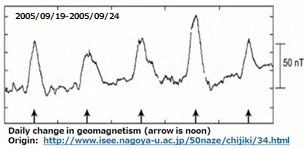
Fig.2.2.6 Diurnal variation of the geomagnetic field measured on Gum Island
The geomagnetic field measured at 13.45 north latitude on Gum Island increases
by about 50 nT (about 0.1% of the geomagnetic field) around noon. This
phenomenon is caused by sunlight and solar wind. At around noon, when H+ of the solar wind irradiats the front, Since the solar wind has a rotating
component in the counterclockwise rotation direction, it drives charged
particles in upper sky in the direction of clockwise rotation and weakens
the geomagnetic field associated with the rotation of the Earth. On the
other hand, free electrons generated by ionizing the atmosphere in the
upper atmosphere due to irradiation such as ultraviolet rays of sunlight
reduces the effect of weakening the geomagnetic field. So,y, we can explain
the diurnal change in which the geomagnetic field increases slightly.
Thus, the motion of the charged particles of the Earth and the motion
of the charged particles of the solar wind interact. The explanation that
"the Earth has a geomagnetic field, and magnetic field lines surround
the earth, so the ground is protected from charged particles flying from
the sun" is incorrect.
目次へ -2.2-